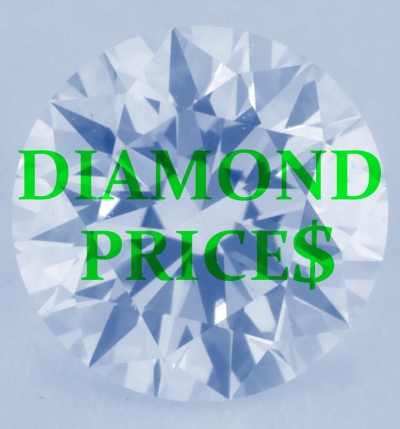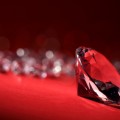Lab-grown or synthetic diamonds are created through an artificial process in a laboratory as opposed to being formed naturally in the earth. Synthetic diamonds are also referred to as created, cultivated or cultured diamonds.

Man-made/synthetic diamonds are no different from mined stones in terms of appearance or physical properties.
Are Lab-Grown Diamonds Different from Natural Diamonds?
Although a lot of people think of fake diamonds when they hear the word “synthetic”, lab-created diamonds are actually identical to natural ones in terms of chemical structure.
Synthetic diamonds are no different from mined stones in terms of appearance or physical properties, so if you buy a synthetic diamond, nobody would be able to distinguish it from a natural one.
Don’t confuse synthetic diamonds with diamond simulants such as cubic zirconia – unlike created diamonds, simulants are not made of the same material as natural diamonds are.
How Natural Diamonds Are Created
Diamond is a substance that is made of carbon and has a crystal structure. In nature, diamonds are formed deep inside the earth, under high pressure and temperature.
What is remarkable is that these beautiful stones you see in all kinds of jewelry are actually billions of years old.
How Lab-Grown Diamonds Are Made
In contrast to natural diamonds, their synthetic counterparts are created in laboratory conditions.
High temperature and pressure are used to mimic the conditions present during the formation of diamonds in nature.
Related: If you are looking to buy diamond jewelry or a loose diamond, check out this selection of diamonds, each of which you can have set in a ring.
Advantages of Lab-Grown Diamonds
One of the biggest advantages to buying a synthetic diamond is that compared with a similar natural stone, the created one is cheaper.
When you also consider the fact that synthetic stones usually don’t have large and visible inclusions, you realize that you can get a flawless or nearly flawless diamond at a lower price than what you would pay for a naturally clean stone.
Prices of Lab-Grown Diamonds
Price is one of the main attractions of lab-created diamonds. Because synthetic stones are man-made, they are also cheaper than natural diamonds, which are rare and hard to mine.
So, how much can you save by buying a lab-grown diamond? Depending on the quality of the stone, you can expect to pay at least 10-15% less for a created diamond than for a natural one with similar characteristics.
Evaluating the Clarity of Lab-Grown Diamonds
One of the major advantages of lab-grown diamonds is that they are nearly flawless and don’t have as many inclusions as you would find in naturally formed stones.
It’s not that synthetic diamonds don’t have flaws or impurities at all, but these imperfections are minimized through strict control over the production process.
You should evaluate the clarity of a synthetic diamond as you would assess that of a mined diamond: The synthetic stone should be eye clean, i.e., no flaws should be visible with the naked eye.
When you look at a synthetic diamond, it is unlikely that you will see the kind of prominent inclusions that you would spot in a low-clarity natural stone.
Evaluating Color
Evaluating the color of lab-grown diamonds is no different from judging the color of mined stones: The less color it shows, the better.
If you are looking for a stone to set in a white metal, for example, look for diamonds that are perfectly white, without any visible tints. Generally, it is easier to produce high-quality color in synthetic diamonds than to find naturally colorless diamonds.
Synthetic diamonds are available in a variety of colors other than white, and in general, synthetics are a great option if you are looking for fancy-colored diamonds, which are rare to find in their natural state.
Cut of Lab-Grown Diamonds
As with color and clarity, evaluating the cut of a synthetic diamond is no different from assessing that of a natural diamond. And the more proportional the cut, the better the brilliance and sparkle of the stone will be.
The rule of thumb when judging cut is to look for symmetry: If the stone is cut round, it should not be too deep or too shallow when seen from the side.
The facets of the stone should be well aligned and proportional. The girdle (the edge of the stone) should not be too thick (as it would make the stone disproportional) or too thin (as it could easily break).
Carat Weight and Lab-Grown Diamonds
One issue with synthetic diamonds is that there is a limited selection of sizes for top-quality stones due to technological limitations.
For example, most high-quality synthetic diamonds won’t come in carat weights greater than 0.5 carats, and you will rarely find a good stone that exceeds 1.5 carats, although the technology is improving.
If you are looking for a colored stone, however, you will have more choice: You may be able to find a diamond that is up to 3 carats in weight.
Certification of Synthetic Diamonds
When evaluating the quality characteristics of a synthetic diamond, it is good to have a certificate that lists the grades of the stone’s color, clarity and cut.
The Gemological Institute of America (G.I.A.) grades synthetic diamonds and issues certificates that explicitly state that the stone evaluated is synthetic.
If you are shopping for lab-grown diamonds, it is a good idea to ask for such a document so you can establish that the advertised characteristics of the stone are indeed true.
How Can You Detect Lab-Grown/Synthetic Diamonds?
It is very hard to detect a lab-grown diamond just by looking at it. Even if you use a loupe or microscope, you won’t be able to find a visible difference. After all, synthetics have the same chemical structure as natural diamonds.
In order to detect a synthetic diamond reliably, you will need special tools that can analyze the structure of a stone on a very detailed level.
Such equipment is usually found in gemological laboratories, which inspect and grade diamonds and other gemstones.
The best way to easily tell if a diamond is lab-grown is to look at its grading certificate.
Most major gemological labs that grade diamonds include in their reports information on whether a stone is a natural diamond or a result of a synthetic production process.
For example, the reports issued by the GIA (Gemological Institute of America) indicate whether a diamond is man-made.
Apart from checking a stone’s certificate, there is a rule of thumb you can use to figure out whether a stone is likely to be synthetic. In general, if a diamond is more than 5%-10% cheaper compared with another, natural diamond of the same carat and with the same grades for clarity, color, and cut, then the cheaper stone might be synthetic.
Price is not a reliable indicator that a diamond is or isn’t synthetic, however – it is just an indication of probability. It’s better to rely on the stone’s certificate – yet another reason to prefer certified diamonds over those that don’t come with a grading report.
Lab-Grown Diamonds vs. Cubic Zirconia
Cubic zirconia and synthetic diamonds differ in their physical and chemical properties. Here are some of the most noticeable differences:
Durability
Lab-grown diamonds are significantly more durable than cubic zirconia.
This is mainly due to the differences in hardness between these stones: While synthetic diamonds are rated 10 on the Mohs scale of hardness, cubic zirconia has a rating of 8.5.
For this reason, cubic zirconia is much easier to scratch and is generally less durable than lab-created diamonds.
Facets and Cut
Since cubic zirconia is softer than lab-grown diamonds, when cut and polished, these two materials differ in how sharp the edges of their facets are.
Synthetics, like natural diamonds, have facets with very sharp edges. Faceted cubic zirconia stones, on the other hand, have edges that are more rounded, and with time, they become even rounder as the material wears out.
Tip: If you are looking to buy real diamond jewelry, we recommend that you buy from a place where you can see the actual stone before the purchase. James Allen is one such retailer that allows you to see each loose diamond from all sides with its 360-degree diamond display technology.
Fire (Dispersion)
Another difference between cubic zirconia and lab-grown diamonds is in the level of their dispersion. This property is directly related to how a stone breaks down light into a rainbow of spectral colors – an effect also called “fire.”
Cubic zirconia has higher dispersion, and for this reason, when exposed to light, this stone exhibits flashes that are more colorful than those in a synthetic diamonds.
Weight
Cubic zirconia is a material that is heavier than natural and synthetic diamond.
Therefore, if you weigh a cubic zirconia stone and compare its weight with that of a synthetic diamond of similar size, the cubic zirconia should be significantly heavier.
Price
Lab-grown diamonds have the same properties as natural diamonds, and although synthetics are cheaper to produce, they are still relatively expensive compared with cubic zirconia.
Actually, it is very often the case that a cubic zirconia costs a fraction of the price of a created diamond of similar size, color, and clarity.
Color and Clarity: More Similar than Different
Although cubic zirconia usually is clearer and more colorless than most natural diamonds due to its synthetic origin, lab-grown diamonds are more likely to have color and clarity that are just as good.
While lab-created diamonds can have yellowish tints and sometimes even have natural-looking flaws, the artificial process used to produce these stones usually ensures that defects are minimized, as is the case with cubic zirconia.
For that reason, how clear and colorless a stone looks should not be your primary way of telling syntehtic diamonds from cubic zirconia.
Heat and Electric Conductivity: The Best Way to Test
Lab-grown diamonds and cubic zirconia differ in the way they conduct heat and electricity. This makes it easy to tell them apart with a diamond tester, which is basically a device that measures the conductive properties of materials.
This is also why using such a tool is the most certain way to tell whether the stone you have is a diamond or something else.
(Most diamond testers will indicate whether a stone is a diamond, but if it is not, they will not tell you whether it is cubic zirconia.)
Where to Buy Diamond Jewelry?
We recommend James Allen (read review) because you can see a 360-degree video for any diamond before buying it.
Blue Nile is another reputable diamond retailer we recommend.














